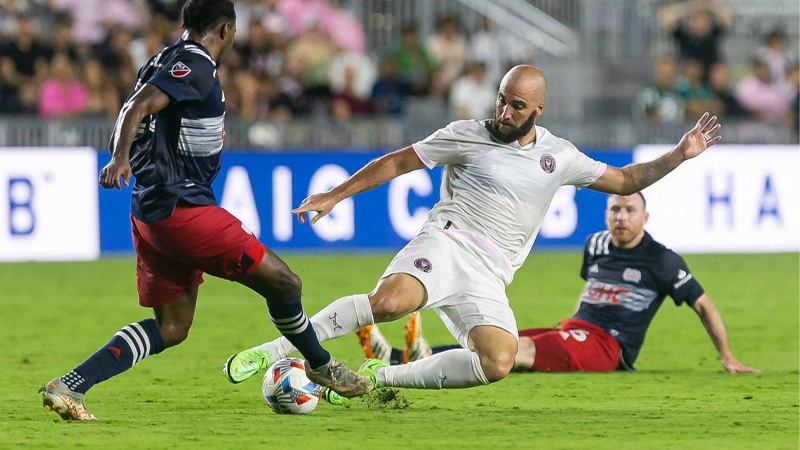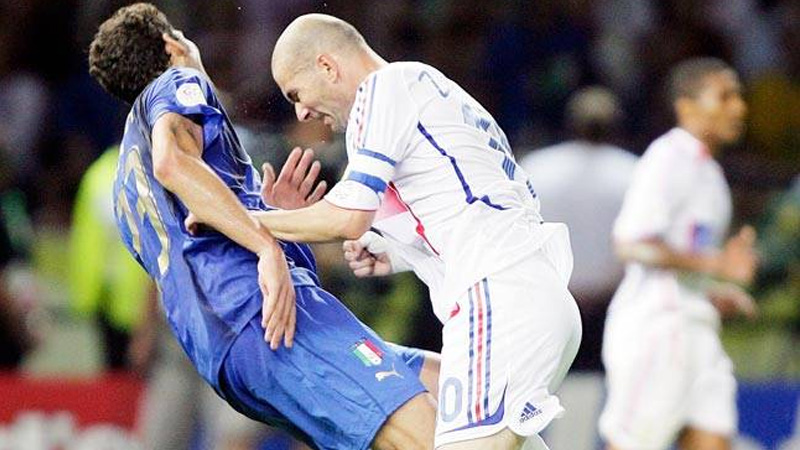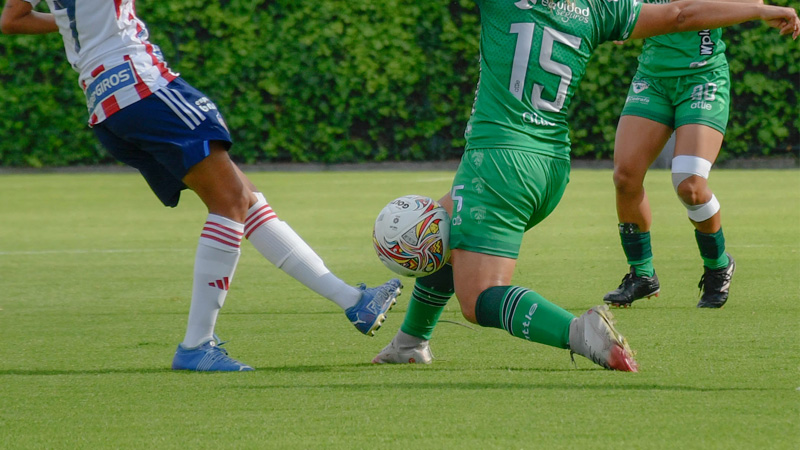In soccer, striking an opponent is a foul that is committed when a player physically contacts or attempts to contact an opponent with a part of their body other than their foot.
This can include hitting, elbowing, head-butting, kneeing, and bumping. Throwing a ball or other object at an opponent also counts as striking an opponent.
Striking an opponent is a serious foul and can result in a direct free kick, a yellow card, or even a red card. The severity of the punishment will depend on the degree of force used and the intent of the player.
It’s important for soccer players to be aware of the rules regarding striking an opponent. By understanding the consequences of this foul, players can help to keep the game safe and fair for everyone involved. So, let’s learn all the details about soccer striking an opponent foul.
What Is Soccer Striking an Opponent Foul?
In soccer, striking an opponent is considered a foul and is typically penalized by the referee. The specific foul that is committed when striking an opponent depends on the nature and severity of the action.
Here are a few common fouls related to striking an opponent in soccer:
Kicking an Opponent
If a player intentionally kicks an opponent, it is considered a foul. The severity of the kick and the intent behind it will determine the punishment, which can range from a simple free kick to a yellow or red card.
Punching or Striking an Opponent
Any form of punching or striking an opponent with the hand or arm is considered a foul. This action is typically met with a red card, resulting in the player being sent off the field.
Elbowing an Opponent
If a player uses their elbow to strike an opponent, it is considered a foul. Elbowing can cause serious injury, so it is often penalized with a red card.
Headbutting an Opponent
Headbutting, where a player intentionally strikes an opponent with their head, is a serious offense and is usually met with a red card.
It’s important to note that unintentional contact or accidental collisions during the course of play are generally not considered fouls, as soccer is a physical sport and some level of contact is expected.
The referee’s judgment is crucial in determining whether a foul has been committed and what the appropriate punishment should be.
Can You Kick the Ball at Someone in Soccer?

Source: miamiherald
In soccer, intentionally kicking the ball at someone with the intent to harm or injure them is not allowed and is considered a violation of the rules.
It is generally considered unsporting behavior and can result in a foul being called by the referee. The severity of the punishment will depend on the specific circumstances and the referee’s judgment.
However, it’s important to note that unintentional contact or accidental kicks that occur during the normal course of play are generally not considered fouls. Soccer is a physical sport, and some level of contact is expected.
Players often make contact with the ball and inadvertently hit opponents in the process. As long as there is no intent to harm or injure, accidental contact is typically not penalized.
It’s crucial for players to exercise caution and control when kicking the ball to avoid endangering other players on the field. Intentionally kicking the ball at someone with the intent to harm can lead to disciplinary action, including a foul, a yellow card, or even a red card depending on the severity of the action.
What Are the Consequences of Striking an Opponent?
The consequences of striking an opponent in soccer can vary depending on the severity of the action and the referee’s judgment. Here are some potential consequences that a player may face for striking an opponent:
Free Kick or Penalty Kick
If a player commits a less severe strike, such as a minor push or a light slap, the referee may award a free kick or a penalty kick to the opposing team. The location of the free kick or penalty kick will depend on where the foul occurred.
Yellow Card
A more deliberate or reckless strike, such as a forceful kick or a punch, may result in the player receiving a yellow card. A yellow card serves as a warning and is accompanied by a caution from the referee.
If a player receives multiple yellow cards in a match, they may be shown a red card and be sent off the field.
Red Card and Ejection
Striking an opponent with excessive force, such as a violent punch, a dangerous kick, or a deliberate headbutt, is likely to result in a red card.
A red card means that the player is immediately ejected from the game and their team must continue playing with one fewer player for the remainder of the match. The player may also face additional disciplinary action, such as a suspension for future games.
Potential Fines or Further Disciplinary Action
In addition to the consequences within the game, striking an opponent can lead to further disciplinary action by the soccer governing body. This can include fines, extended suspensions, or other penalties depending on the severity of the offense.
It’s important to note that the consequences for striking an opponent can vary depending on the specific league, tournament, or competition rules. The severity of the action and the referee’s interpretation play a significant role in determining the consequences.
Examples of Striking an Opponent Foul in Soccer

Source: indiatoday
There have been several notable examples of soccer players committing fouls by striking opponents. Here are a few popular examples:
Zinedine Zidane’s Headbutt (2006 World Cup Final)
In the 2006 FIFA World Cup, Final between France and Italy, French captain Zinedine Zidane headbutted Italian defender Marco Materazzi in the chest. Zidane was shown a red card and sent off in his final professional match.
Luis Suarez Biting Incidents
Uruguayan striker Luis Suarez has been involved in multiple biting incidents throughout his career. In 2010, while playing for Ajax, he bit PSV Eindhoven’s Otman Bakkal.
In 2013, while playing for Liverpool, he bit Chelsea’s Branislav Ivanovic. And in the 2014 FIFA World Cup, he bit Italy’s Giorgio Chiellini while representing Uruguay. Suarez faced suspensions and disciplinary actions for these incidents.
Eric Cantona’s Kung-Fu Kick
In 1995, Manchester United’s Eric Cantona launched a kung-fu-style kick towards a Crystal Palace fan who had been taunting him during a match. Cantona was sent off and later faced legal consequences, including community service and a lengthy ban from playing.
Nigel De Jong’s Chest-High Challenge
In the 2010 FIFA World Cup Final between the Netherlands and Spain, Dutch midfielder Nigel de Jong made a high and dangerous challenge on Spanish midfielder Xabi Alonso.
De Jong’s challenge involved extending his leg and making contact with Alonso’s chest. Although he received only a yellow card, the incident sparked controversy due to the potential for serious injury.
Paolo Di Canio’s Push on Paul Alcock
In 1998, during a Premier League match between Sheffield Wednesday and Arsenal, Italian forward Paolo Di Canio pushed referee Paul Alcock after being shown a red card.
The force of the push caused Alcock to fall to the ground, resulting in widespread condemnation and a lengthy ban for Di Canio.
Pepe’s Headbutt on Thomas Müller
In the 2014 FIFA World Cup, during a match between Portugal and Germany, Portuguese defender Pepe headbutted German forward Thomas Müller.
The incident occurred after a minor altercation between the two players. Pepe was shown a red card and faced criticism for his unsportsmanlike behavior.
These examples highlight instances where players have committed fouls by striking opponents, resulting in disciplinary actions, red cards, and sometimes legal consequences.
It’s important to note that these incidents are not representative of the majority of soccer matches, as most players adhere to the rules and play the game in a fair and sportsmanlike manner.
FAQs
What happens if a player strikes an opponent in soccer?
If a player strikes an opponent in soccer, the consequences can range from a simple foul and free kick to receiving a yellow or red card, depending on the severity of the action. More serious strikes can result in immediate ejection from the game and potential further disciplinary action.
Can accidental contact be considered a striking foul in soccer?
Accidental contact or unintentional strikes that occur during the normal course of play are generally not considered fouls in soccer. The intent to harm or injure is an important factor in determining whether a striking foul has been committed.
Are there any exceptions to striking an opponent being a foul in soccer?
There are certain situations where striking an opponent may not be considered a foul, such as when a player legally wins the ball during a tackle or when a player strikes the ball and it inadvertently hits an opponent.
What is the punishment for striking an opponent in professional soccer?
The punishment for striking an opponent in professional soccer can vary depending on the severity of the action and the referee’s judgment.
It can range from a simple free kick or penalty kick to receiving a yellow or red card, which may result in immediate ejection from the game and potential further disciplinary action.
How does the referee determine if a striking foul has been committed in soccer?
The referee uses their judgment to determine if a striking foul has been committed in soccer. They consider factors such as the intent behind the action, the force used, and the potential for injury. The referee’s decision is final and can have significant consequences for the player committing the foul.
Final Words
As the final whistle blows, the debate surrounding the soccer striking an opponent foul continues to rage on. While some argue for stricter punishments to protect players’ safety, others advocate for maintaining the physicality and intensity that make soccer the sport we love.
Finding the delicate balance between fair play and the spirit of competition remains a challenge for governing bodies and referees alike.
Ultimately, the soccer striking an opponent foul serves as a reminder of the complexities inherent in the game. It sparks discussions about sportsmanship, ethics, and the responsibility of players to uphold the integrity of the sport.
As soccer evolves, so too will the rules and interpretations surrounding this contentious foul, ensuring that the game continues to captivate and inspire fans around the globe.







